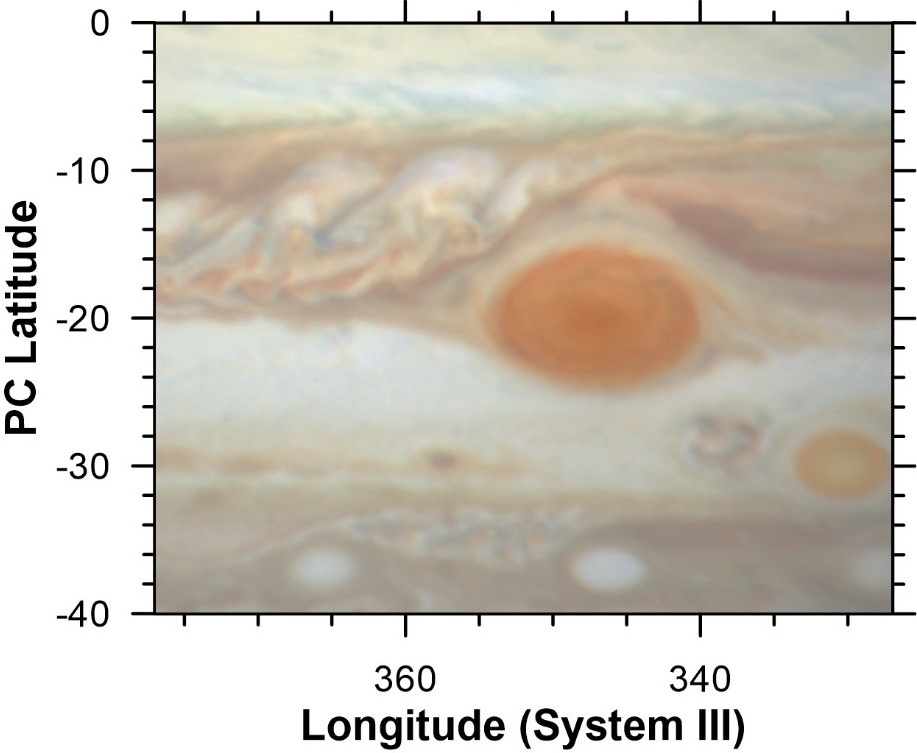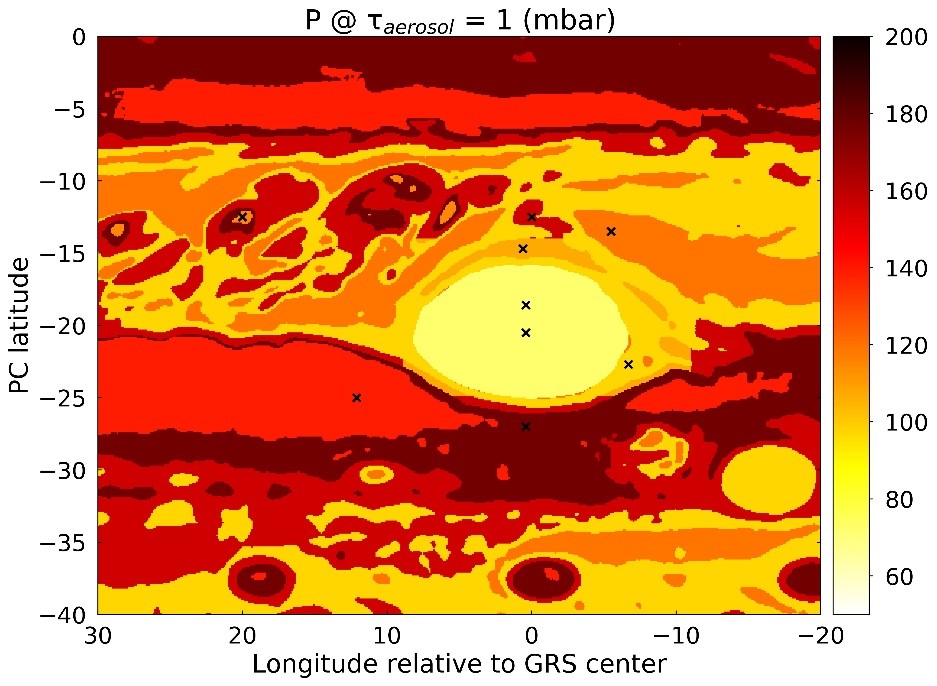Formation and structure of hazes over Jupiter’s Great Red Spot
- Dpto. Física Aplicada, EIB, Universidad del País Vasco UPV/EHU, 48013 Bilbao, Spain
Introduction
The Great Red Spot of Jupiter (GRS) is the largest and longest-lived anticyclone in the Solar System. First observed probably in the XVII century, it is one of the most remarkable dynamical phenomena in any known atmosphere. The structure, coloration and dynamical behavior of the Jovian anticyclone are severely affected by the formation and evolution of the GRS upper hazes, making them a relevant field of study.
The distinctive reddish color of the GRS (see Figure 1) is due to the nature and vertical distribution of the hazes over it. Carlson et al. (2016) proposed a possible chromophore to explain the GRS coloration: the products from photolyzed ammonia reacting with acetylene. Sromovsky et al. (2017) showed that this species was able to explain the reddish colorations all over the planet, despite being of very different intensity. This chromophore must be located on top of the tropospheric haze, in the so called “crème brûlée” model. Anguiano-Arteaga et al. (2021) performed a radiative transfer analysis that showed the existence of a stratospheric haze that could be compatible with the chromophore agent proposed by Carlson et al. (2016), although their study also suggested another chromophore located below that, in the upper tropospheric levels. However, every single color in the region shown in Figure 1 was also explained with those two chromophores. In a recent paper (Anguiano-Arteaga et al., 2022) we find that the results of Anguiano-Arteaga et al. (2021) remain valid at least from 2015 to 2021, and no major temporal variations are expected in years close to such time span.

Figure 1. Map showing Jupiter’s Great Red Spot in December 2016. The RGB images are constructed from HST/WFC3 images with R=F631N, G=F502N and B=F395N. Image taken from Anguiano-Arteaga et al. (2022).
Vertical structure of the GRS
Images taken in filters sensitive to the altitude of the clouds and hazes show that the cloud top of the GRS is higher than its environment. The altitude of the hazes plays a major role in the coloration and dynamics. For example, in the scheme proposed by Carlson et al. (2016) material in the GRS raises to upper pressure levels and undergoes photochemical reactions that lead to the creation of the coloring agent. The amount of material high in the atmosphere would be then a fundamental factor to determine the production rate of chromophore species. Radiative transfer analyses give some insight on the altitude of the clouds and hazes. In Figure 2, we show maps of cloud top effective altitudes obtained from radiative transfer spectral modeling, as shown in Anguiano-Arteaga et al. (2021, 2022). However, radiative transfer analyses cannot provide some important information on the hazes, such as chromophore production rates or timescales of the undergoing atmospheric processes (e.g., coagulation, condensation and sedimentation). Because of this, microphysical considerations should be also taken into account in order to get a more complete description of the nature, structure and evolution of the hazes.

Figure 2. Map of the GRS area in December 2016 showing the pressure levels (in mbar) where the optical depth at 900 nm equals unity. This map is interpreted as the cloud top effective altitude.
Microphysical study
In this work, we perform microphysical simulations of the GRS hazes in the stratosphere and upper troposphere (P < 500 mbar). For this purpose, we develop a 1-D numerical code that takes into account the effects of particle sedimentation, coagulation, eddy diffusion and aerosol growth by molecular condensation. We report here results on the particle size distribution as a function of altitude, together with aerosol concentrations and timescale analysis regarding different microphysical processes. This constrains the mass production rates required to explain the chromophore model and hence serves as a test for any given proposed candidate. The results are interpreted according to prior findings following radiative transfer analysis on the GRS.
References
- Anguiano-Arteaga, A., Pérez-Hoyos, S., Sánchez-Lavega, A., Sanz-Requena, J. F., & Irwin, P. G. J. (2021). Vertical distribution of aerosols and hazes over Jupiter's Great Red Spot and its surroundings in 2016 from HST/WFC3 imaging. J. Geophys. Res. Planets., 126, e2021JE006996 https://doi.org/10.1029/2021JE006996
- Anguiano-Arteaga, A., Pérez-Hoyos, S., Sánchez-Lavega, A., Sanz-Requena, J. F., & Irwin, P. G. J. (2022). Temporal variations in vertical cloud structure of Jupiter’s Great Red Spot, its surroundings and oval BA from HST/WFC3 imaging. Submitted to J. Geophys. Res. Planets.
- Carlson, R.W., Baines, K.H., Anderson, M.S., Filacchione, G., & Simon, A.A. (2016). Chromophores from photolyzed ammonia reacting with acetylene: Application to Jupiter’s Great Red Spot. Icarus, 274, 106-115. https://doi.org/10.1016/j.icarus.2016.03.008
- Sromovsky, L.A., Baines, K.H., Fry, P.M., & Carlson, R.W. (2017). A possibly universal red chromophore for modeling color variations on Jupiter. Icarus, 291, 232-244. https://doi.org/10.1016/j.icarus.2016.12.014
How to cite: Anguiano-Arteaga, A., Pérez-Hoyos, S., and Sánchez-Lavega, A.: Formation and structure of hazes over Jupiter’s Great Red Spot, Europlanet Science Congress 2022, Granada, Spain, 18–23 Sep 2022, EPSC2022-324, https://doi.org/10.5194/epsc2022-324, 2022.

